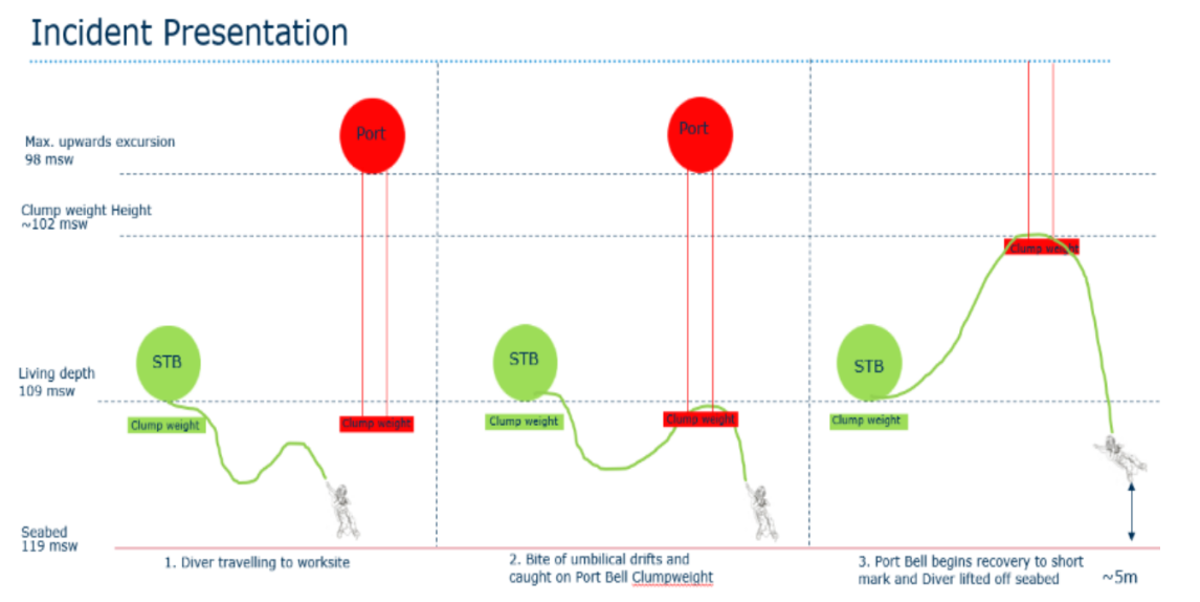Diver lifted off seabed
- Safety Flash
- Published on 6 March 2025
- Generated on 11 January 2026
- IMCA SF 04/25
- 3 minute read
Jump to:
A diver was lifted off the seabed when their umbilical was caught by a diving bell clump weight adjustment prior to bell recovery.
What happened?
When moving from the bell to the worksite, a bight of the Starboard Diver 2’s umbilical fouled on the port bell clump weight. When the port bell was raised to a short mark (approximately 10m from deployed position) by the Diving Supervisor, Starboard Diver 2 was lifted off the seabed to a height of approximately 4-5m due to the caught umbilical.
Upon recognition that the diver had been lifted off the seabed, the Diving Supervisor called an ALL STOP and the port bell clump weight was lowered until Starboard Diver 2’s umbilical was cleared. The diver returned to the bell, where he and his equipment was assessed. At no point did the diver lose any of his services. Diver 2 was cleared to return to work using Diver 3’s equipment. (The bell in use was configured to having 3 working divers out of the bell in addition to the bellman).

Schematic of the actual and potential excursions related to the work and the operation.
What went wrong?
- The route taken by the diver from the Starboard bell to the worksite meant that his umbilical was close to the port bell and its clump weight;
- The risk of snagging of the umbilical on the clump weight had not been recognised.
Lessons to learn
- Given that the diver from the starboard bell had to pass close to the port bell, the observation ROV should have been designated to focus on diver umbilical;
- Divers required to pass close to objects to be lifted or moving from one workplace to another should be monitored by a second diver or by an ROV.
A Time Out For Safety (TOFS) was held in Dive Control, with all on shift divers in attendance to recognise, to discuss and communicate the near miss which had occurred with. Further discussion was held by Offshore Managers and supervisors. Matters to discuss included:
- Behaviours - Line of Fire:
̶ Tidal effects and current on umbilical slack;
̶ The path that the diver takes and proximity to objects to be lifted;
̶ Umbilical drifting;
- Personal Factors – Inattention: the possibility of the snagging of the umbilical could have been recognized prior to lifting;
- Use of the observation ROV to focus on the diver during his path to the worksite or between worksites.
IMCA Safety Flashes summarise key safety matters and incidents, allowing lessons to be more easily learnt for the benefit of the entire offshore industry.
The effectiveness of the IMCA Safety Flash system depends on the industry sharing information and so avoiding repeat incidents. Incidents are classified according to IOGP's Life Saving Rules.
All information is anonymised or sanitised, as appropriate, and warnings for graphic content included where possible.
IMCA makes every effort to ensure both the accuracy and reliability of the information shared, but is not be liable for any guidance and/or recommendation and/or statement herein contained.
The information contained in this document does not fulfil or replace any individual's or Member's legal, regulatory or other duties or obligations in respect of their operations. Individuals and Members remain solely responsible for the safe, lawful and proper conduct of their operations.
Share your safety incidents with IMCA online. Sign-up to receive Safety Flashes straight to your email.